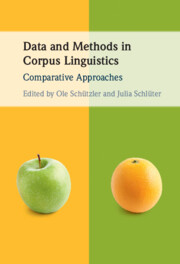Book contents
- Data and Methods in Corpus Linguistics
- Data and Methods in Corpus Linguistics
- Copyright page
- Contents
- Figures
- Tables
- Contributors
- Acknowledgements
- Introduction: Comparative Approaches to Data and Methods in Corpus Linguistics
- Part I Corpus Dimensions and the Viability of Methodological Approaches
- 1 Comparing Standard Reference Corpora and Google Books Ngrams
- 2 Comparing Approaches to Phonological and Orthographic Corpus Formats
- Part II Selection, Calibration and Preparation of Corpus Data
- Part III Perspectives on Multifactorial Methods
- Part IV Applications of Classification-Based Approaches
- Index
- References
1 - Comparing Standard Reference Corpora and Google Books Ngrams
Strengths, Limitations and Synergies in the Contrastive Study of Variable h- in British and American English
from Part I - Corpus Dimensions and the Viability of Methodological Approaches
Published online by Cambridge University Press: 06 May 2022
- Data and Methods in Corpus Linguistics
- Data and Methods in Corpus Linguistics
- Copyright page
- Contents
- Figures
- Tables
- Contributors
- Acknowledgements
- Introduction: Comparative Approaches to Data and Methods in Corpus Linguistics
- Part I Corpus Dimensions and the Viability of Methodological Approaches
- 1 Comparing Standard Reference Corpora and Google Books Ngrams
- 2 Comparing Approaches to Phonological and Orthographic Corpus Formats
- Part II Selection, Calibration and Preparation of Corpus Data
- Part III Perspectives on Multifactorial Methods
- Part IV Applications of Classification-Based Approaches
- Index
- References
Summary
This chapter is based on two standard reference corpora, the British National Corpus and the Corpus of Contemporary American English, as opposed to the multi-billion-word database of Google Books Ngrams, which has, despite its allure, not been used in many systematic linguistic studies so far. Focusing on indefinite article allomorphy (a vs an) as an orthographic cue to the phonological strength of ‹h›-onsets in British and American English, the size advantage of the Ngrams database expectedly plays out in larger type and token counts, more stable estimates and fewer distortions due to data sparsity. However, as metadata are extremely limited (to year and variety), a fully accountable analysis is not feasible. The case study illustrates how richly annotated corpora can shed light on potential disturbances arising from two sources: genre differences and between-author variability. A sensitivity analysis offers some degree of reassurance when extending the analysis to the Ngrams database. In this way, the authors demonstrate that the strengths and limitations of corpora and big data resources can, with due caution, be counterbalanced to answer questions of linguistic interest.
Keywords
- Type
- Chapter
- Information
- Data and Methods in Corpus LinguisticsComparative Approaches, pp. 17 - 45Publisher: Cambridge University PressPrint publication year: 2022

